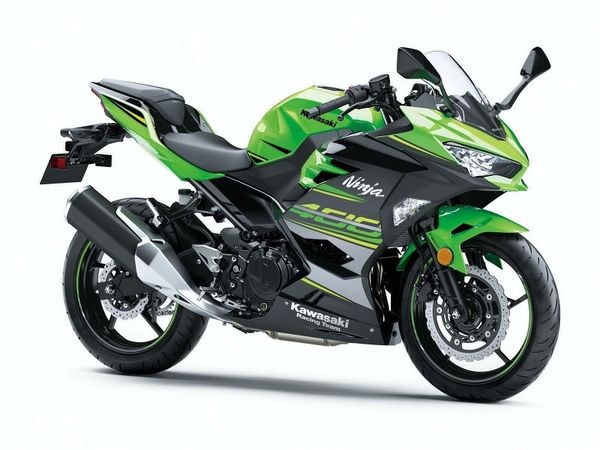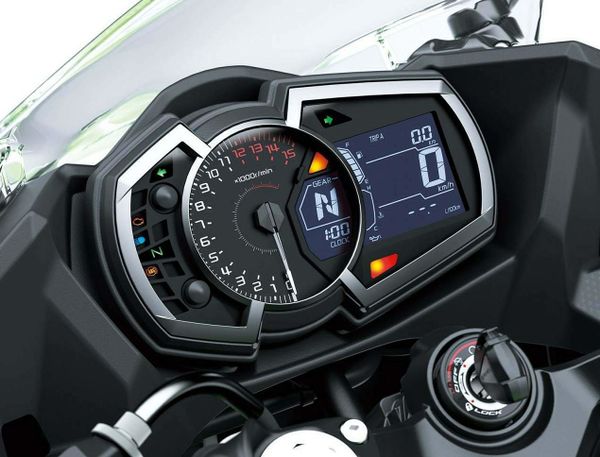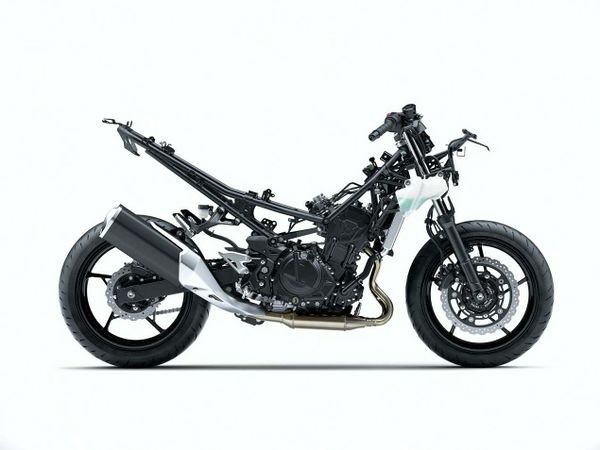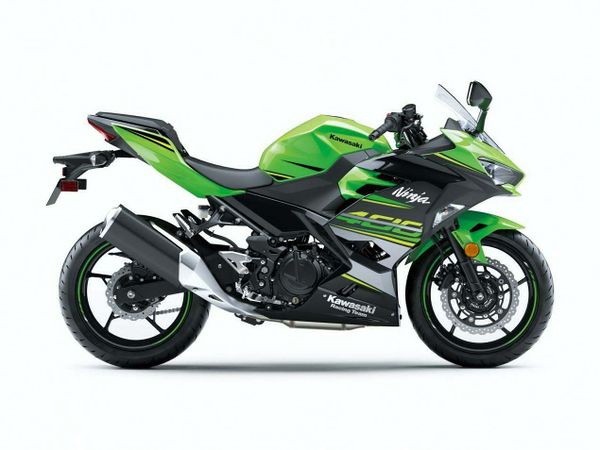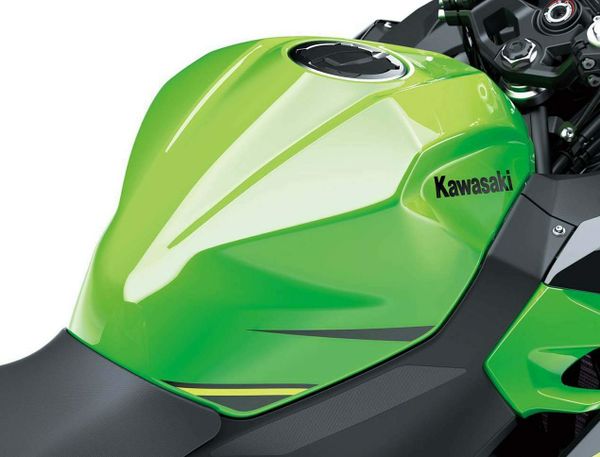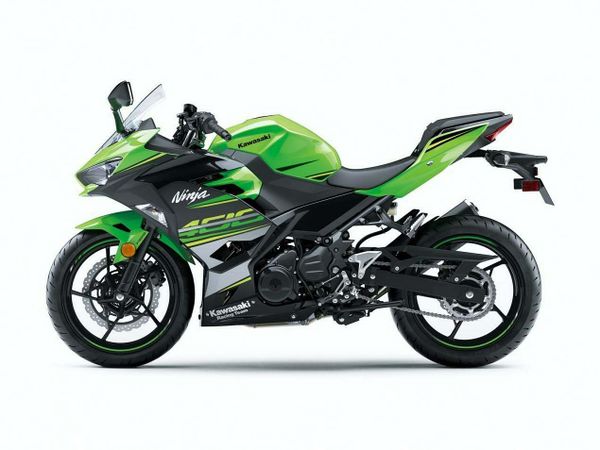Kawasaki Ninja 400 / ABS KRT
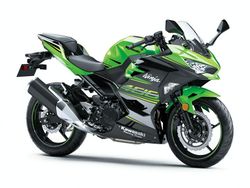 |
|
| Kawasaki Ninja 400 / ABS KRT | |
| Manufacturer | |
|---|---|
| Production | 2018 |
| Engine | Four stroke, parallel twin cylinder. DOHC, 4 valves per cylinder. |
| Compression ratio | 11.6:1 |
| Ignition | TCBI with digital advance / electric |
| Transmission | 6 Speed |
| Frame | Trellis, high-tensile steel |
| Suspension | Front: 41 mm telescopic fork Rear: Bottom-Link Uni-Trak, gas-charged shock with adjustable preload |
| Brakes | Front: Single semi-floating 310mm disc, Single balanced actuation dual-piston Rear: Single 220mm disc, Dual-piston |
| Front Tire | 110/70-17 M/C 54S |
| Rear Tire | 150/60R17 M/C 66H |
| Wheelbase | 1370 mm / 53.9 in |
| Seat Height | 785 mm / 30.9 in |
| Weight | 166 kg / 366 lbs (wet) |
| Recommended Oil | K-tech 10W-40 |
| Fuel Capacity | 14 Liters / 3.7 US gal |
| Manuals | Service Manual |
Engine[edit | edit source]
The engine was a Liquid cooled cooled Four stroke, parallel twin cylinder. DOHC, 4 valves per cylinder.. The engine featured a 11.6:1 compression ratio.
Drive[edit | edit source]
Power was moderated via the Wet, cable operated.
Chassis[edit | edit source]
It came with a 110/70-17 M/C 54S front tire and a 150/60R17 M/C 66H rear tire. Stopping was achieved via Single semi-floating 310mm disc, Single balanced actuation dual-piston in the front and a Single 220mm disc, Dual-piston in the rear. The front suspension was a 41 mm telescopic fork while the rear was equipped with a Bottom-Link Uni-Trak, gas-charged shock with adjustable preload. The Ninja 400 / ABS KRT was fitted with a 14 Liters / 3.7 US gal fuel tank. The wheelbase was 1370 mm / 53.9 in long.
Photos[edit | edit source]
Overview[edit | edit source]
Kawasaki Ninja 400 KRT
Replacing the Kawasaki Ninja 300 in the lineup, the Kawasaki
Ninja 400 is set to be Team Greens new entry-level model, and
help Kawasaki better compete against bigger bikes like the
Yamaha YZF-R3 and KTM RC390.
Kawasaki says the major driving force behind the new model is
the Euro4 homologation requirements, which required a
clean-slate design.
The Kawasaki Ninja 400 will sport new bodywork which will be
inspired from its elder siblings making it lighter in weight as
compared to its predecessor. Also, the new Ninja 400 will also get
assist-and-slipper clutch which will make the clutch lighter by 20
percent. In terms of styling, the new Ninja 400 motorcycle gets
bodywork inspiration from bigger Ninja H2 which makes it not only
bigger but also wider than the predecessor.
The basic idea for the Ninja 300 carries over to the Ninja 400 though, as the new model will continue to use a 399cc parallel-twin engine (with a larger bore and larger stroke), which makes a touch more power of 45hp, and torque of 38 Nm / 26 lbs-ft than the 300cc model. The unit will be mated to a 6-speed gearbox which will transmit the power to the rear wheels. Despite the larger engine, Kawasaki managed to keep the weight down on the Ninja 400, with the scales tipping in at 168 kg / 370 lbs at the curb. A large part of this weight reduction comes from the smaller fuel tank on the Ninja 400, which is only 13.6 liters / 3.6 gallons (the Ninja 300 had a 17 liters / 4.5 gallon fuel tank).
The motorcycle also gets a 310mm front disc brake which is assisted by Nissin calipers along with ABS.
Get ahead with class-leading power and performance with the all-new Ninja
400. Clad in sharp new Ninja styling, the Ninja 400 has an engine and chassis
that are more powerful and significantly lighter than its Ninja 300 predecessor.
Its stronger engine performance, light, predictable handling and relaxed, sporty
riding position make the Ninja 400 both fun and easy to ride.
Your ride to greatness starts here.
Ninja 400 ABS Kawasaki Racing Team
Kawasaki proudly introduces a new sport model into this highly competitive
arena. Clad in sharp new Ninja styling, the new Ninja 400 delivers greater
performance than its predecessor care of all-new engine and chassis that are
more powerful and significantly lighter. But like the Ninja 300 that preceded
it, this new Ninja model possesses much more than high performance. Not only
does the Ninja 400 offer stunning, high-quality looks, its stronger engine
performance, light, predictable handling and relaxed, sporty riding position
make it both fun and easy to ride.
Features
ERGO-FIT
ERGO-FIT is an interface system that allows a wide range of riders to feel at
one with their machine.ABS
ABS (Anti-lock Brake System) ensures stable braking performance by preventing
wheel lock during braking.
Assist & Slipper Clutch
Based on racing technology, the Assist & Slipper Clutch acts as both a back-torque limiter and a self-servo mechanism that enables a lighter clutch lever pull. Economical Riding Indicator The Economical Riding Indicator is a mark appearing on the instrument panel to indicate favourable fuel consumption, encouraging fuel efficient riding.
| Make Model | Kawasaki Ninja 400 KRT |
|---|---|
| Year | 2018 |
| Engine Type | Four stroke, parallel twin cylinder. DOHC, 4 valves per cylinder. |
| Displacement | 399 cc / 24.3 cu-in |
| Bore X Stroke | 70.0 x 51.8 mm |
| Cooling System | Liquid cooled |
| Compression | 11.6:1 |
| Lubrication | Forced Lubrication, wet sump |
| Induction | Fuel Injection: 32mm x 2 Keihin |
| Ignition | TCBI with digital advance / electric |
| Starting | Electric |
| Max Power | 36 kW / 49 hp @ 10000 rpm |
| Max Torque | 38 Nm / 3.9 kgf.m @ 8000 rpm |
| Clutch | Wet, cable operated |
| Transmission | 6 Speed |
| Final Drive | Chain |
| Gear Ratio | 1st 2.929 (41/14) 2nd 2.056 (37/18) [ 3rd 1.619 (34/21) 4th 1.333 (32/24) 5th 1.154 (30/26) 6th 1.037 (28/27) |
| Primary Reduction Ratio | 2.219 (71/32) |
| Final Reduction Ratio | 2.929 (41/14) |
| Frame | Trellis, high-tensile steel |
| Front Suspension | 41 mm telescopic fork |
| Front Wheel Travel | 120 mm / 4.7 in |
| Rear Suspension | Bottom-Link Uni-Trak, gas-charged shock with adjustable preload |
| Rear Wheel Travel | 130 mm / 5.1 in |
| Front Brakes | Single semi-floating 310mm disc, Single balanced actuation dual-piston |
| Rear Brakes | Single 220mm disc, Dual-piston |
| Front Tire | 110/70-17 M/C 54S |
| Rear Tire | 150/60R17 M/C 66H |
| Rake | 24.7° |
| Trail | 92 mm / 3.6 in |
| Steering Angle (left/right) | 35° / 35° |
| Dimensions | Length 1990 mm / 78.3 in Width 710 mm / 27.9 in Height 1120 mm / 14.0 in |
| Wheelbase | 1370 mm / 53.9 in |
| Seat Height | 785 mm / 30.9 in |
| Ground Clearance | 140 mm / 5.5 in |
| Wet Weight | 166 kg / 366 lbs |
| Fuel Capacity | 14 Liters / 3.7 US gal |
